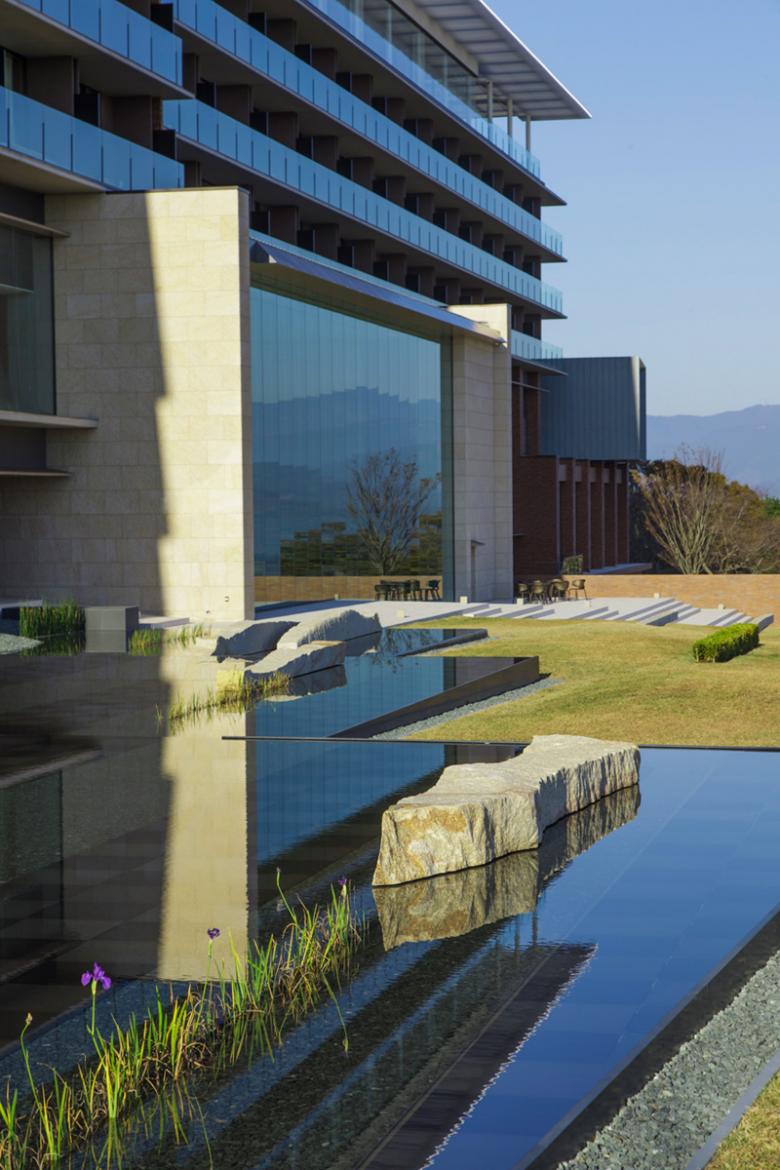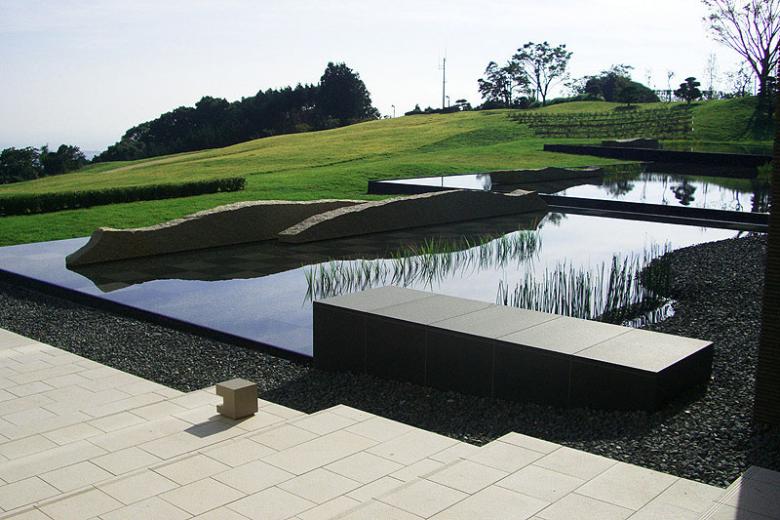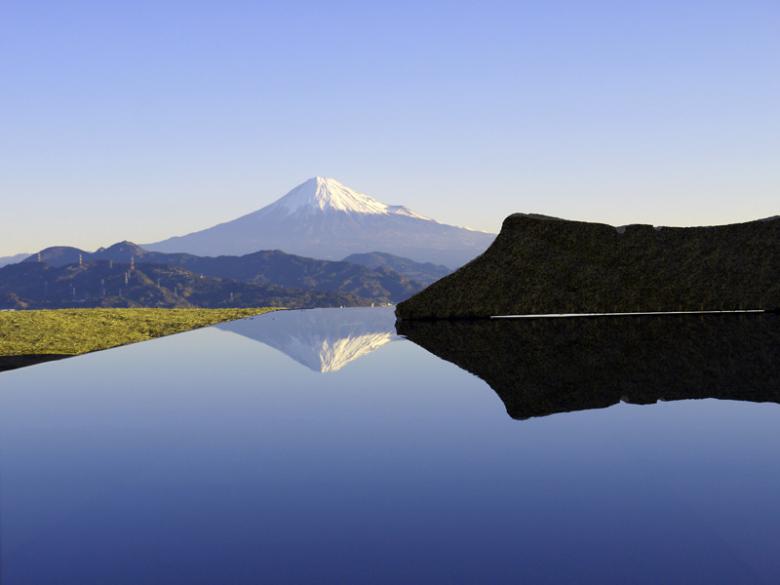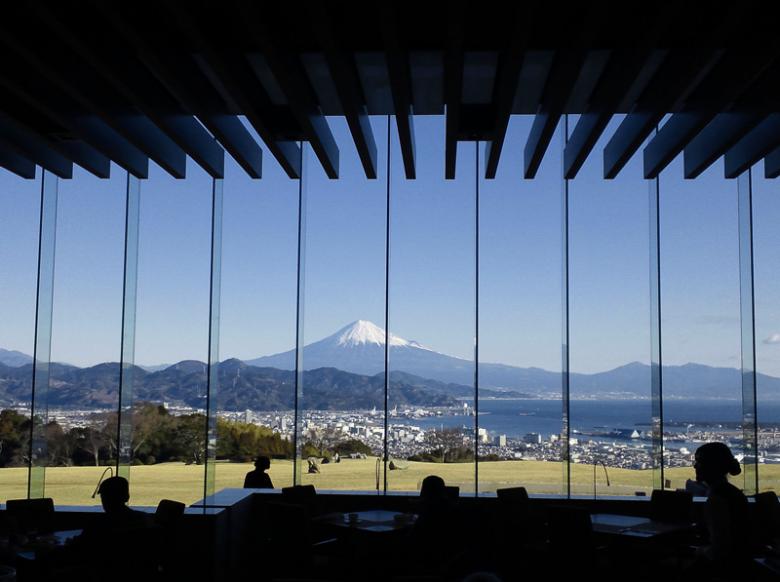Nippondaira Hotel
Nippondaira Hotel
1. April 2013
The Nihondaira Hotel, a long-standing institution on Shizuoka’s scenic Nippondaira plateau, sits within Nihondaira Park. Recently created by Shizuoka's municipal government, the park presents the Nippondaira plateau as an open-air museum of natural landscape art; as part of the project, the hotel was fully rebuilt for the first time since its opening in 1964.
Mitani Landscape Studio’s Hiko Mitani directed landscape design for the hotel rennovation. Taking advantage of the spacious lawn in the foreground and Mt. Fuji, Suruga Bay, and the city lights of Shimizu in the distance, Mitani shaped the everchanging scene into a landscape-scale piece of artwork.
For this month’s Building Review, we focus on landscape architecture in a discussion with Hiko Mitani.
Iris, rocks, hedge and Mt. Fuji
Tell us about your concept for this project.
In designing the landscaping for the hotel, I based my work not on the typical framework of "Japanese-style" or "Western-style" gardens, but instead on the hotel’s concept of "landscape as art museum." By taking advantage of the expansive views unique to the Nippondaira plateau as well as the folds of the land, I aimed to go beyond the concept of "garden as accessory." Instead, I tried to create something that functions as a landscape, linking the building’s interior and exterior spaces and creating dynamic reflections in the surface of the water.
Pond and terrace
How did you decide to take on the project?
In front of the hotel, beyond the gently undulating lawn and the waters of Shimizu Port, towers the awe-inspiring form of Mt.Fuji. That view together with the majestic mountain range that lies in between appealed to me. I wanted to capture it and make it a part of the close-range view of the garden. As a device for doing so, I settled on an extremely simple, shallow pond with a long, massive granite slab set in the center that extends about a centimeter above the surface. I took great care regarding the height of the water surface in which Mt. Fuji would be reflected. I wanted guests to visually enjoy the cool plateau breezes blowing across the wide, shallow surface of the water at the same time as they were enjoying a meal at the hotel restaurant.
The mirror-like surface of the water reflects the landscape of the Nihondaira plateau.
Did the end result differ in any way from the landscape you originally designed? How did you resolve any problems that arose?
Algae tend to grow quickly in shallow ponds, so I devised a system by which the water is constantly in motion as the pond alternates between high and low tides. Also, rather than lining the bank of the pond with rocks, I used crushed local diabase from Shizuoka to create something similar to a natural gravel bank that melds into the interior space. The beautiful color and form of the crushed rock softens the tone of the landscape.
Pond with granite rock and reflection of Mt. Fuji
How does this project relate to your firm’s basic approach to design?
I asked myself what we could possibly accomplish by designing a new landscape in the context of this grand landscape looking out on Mt. Fuji. I think one of the most important results of centering the design around and incorporating Mt. Fuji was that the mass and simplicity of the building that stands in opposition to that landscape was highlighted.
View from restaurant
What do you think the role of landscape architecture is?
What is the place of architecture within the landscape? How to angle the structure and mediate between it and the undulations of the land? I’m talking not just on the scale of a simple garden, but rather on the scale of the landscape as a whole. I believe that by conceiving of architecture and landscape as one - in other words by connecting the two elements – comfortable and high-quality interior and exterior spaces are born.
Stone placed in alignment with Mt. Fuji, directly opposite the hotel.
How does this project fit into current architectural trends?
The building and landscape aren’t ostentatious, but by using affordable materials well, we created an elegant, fulfilling interior and exterior environment that fits with the character of the Nippondaira Plateau.
Site planning
What did you learn from this project? What will you take from it to future work?
I realized the importance of incorporating the dynamic workings of nature, such as the sky, wind, light, and shadow, into landscape design. Through the shallow pond whose water ebbs and flows, guests can sense even over the course of a single meal the natural changes in the landscape. By fully drying out the pond it can even be used as an event space. I want to capture not just the seasonal changes of nature but also the dynamism of a space that changes in a diversity of ways.
E-mail interview by Yuna Yagi (translated from Japanese)
Nippondaira Hotel
2012
Shizuoka
Client
Nippondaira Hotel Co., Inc.
Landscape Architect
Hiko Mitani (Mitani Landscape Studio, Inc.)
Architects
Nikken Sekkei Ltd
Design Principal
Landscaping: Hiko Mitani (Mitani Landscape Studio, Inc.)
Architect: Tatsuya Murai (Nikken Sekkei Ltd)
Contractor
Kiuchi Construction Co. Ltd.
Landscape Contractor
Inaji Landscape & Construction
Stonework
Izumiya Sekizai
Site Area
75,769.13㎡
Building Area
6,153.43㎡
Total Floor Area
18,678.62㎡






